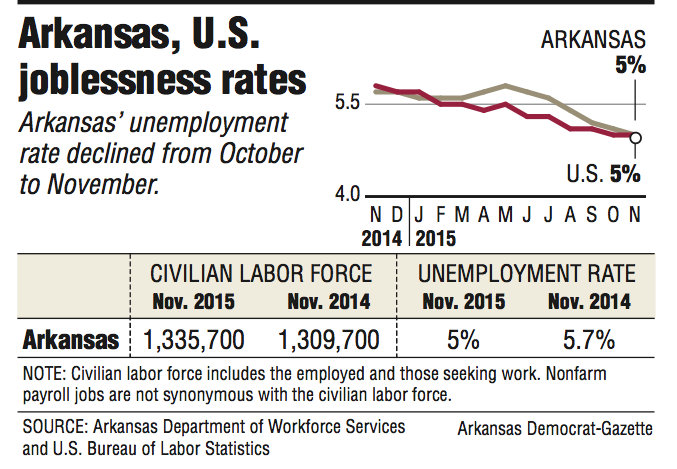Arkansas' unemployment rate fell to 5 percent in November, matching the national rate, the U.S. Bureau of Labor Statistics said Friday.
It was the first time since April 2008 that Arkansas' unemployment rate was as low as 5 percent, Susan Price of the Arkansas Department of Workforce Services said.
It also was the first time since January that Arkansas' unemployment rate was even with or better than the national rate. In January, Arkansas had an unemployment rate of 5.6 percent compared with a national rate at 5.7 percent.
Arkansas had an unemployment rate of 5.1 percent in October.
There were 8,200 fewer unemployed Arkansans last month than in November last year. There were 34,200 more Arkansans with jobs than a year earlier.
Friday's report was not significantly different from those of previous months, said three economists in the state.
"This is consistent with reports we've been getting over the past three or four months," said Michael Pakko, chief economist at the Institute for Economic Advancement at the University of Arkansas at Little Rock.
Kathy Deck, director of the Center for Business and Economic Research at the University of Arkansas at Fayetteville, and Greg Kaza, executive director of the Arkansas Policy Foundation in Little Rock, agreed.
"I think employment growth in Arkansas is still very good," Deck said.
Kaza said an unemployment rate of 5 percent is approaching full employment.
"Some argue that it is 5 percent, but I was taught that 4 percent is full employment," Kaza said.
Full employment is a state of the economy in which all eligible people who want to work can find employment at prevailing wages.
"The unemployment rate being as low as it is is good news," Kaza said.
The state's economy has been expanding since mid-2009, when the recession ended, Kaza said.
There were seven industry sectors with year-over-year job growth and four with declines.
The professional and business services sector gained 6,000 jobs in the previous year, the biggest increase among the 11 sectors.
Education and health services had added 5,900 jobs since November last year.
Construction, a sector that was reporting annual declines in jobs as recently as mid-2014, added 5,700 jobs in November compared with November last year.
"The expansion of employment in Arkansas' construction sector from November 2014 to November 2015 was 12.2 percent, the fastest growth rate among the [44] states where construction employment is reported separately," Pakko said.
In October, construction in the Little Rock area was growing at the 12th-fastest rate among 358 metropolitan areas in the country, the Associated General Contractors of America reported early this month.
The national trade association suggested several ways to make it easier for schools, local contractor associations and construction companies to set up their own training and development programs for new construction workers, a spokesman for the national association said earlier this month at a news conference in Little Rock.
"Unless we act on these recommendations, the construction industry in Arkansas and around the country will face worker shortages with increasing frequency," Brian Turmail, a spokesman for the association, said.
Sectors that are still showing weakness include manufacturing as well as mining and logging, Deck said.
Manufacturing lost 5,700 jobs in November compared with a year earlier. The mining and logging sector lost 800 jobs, almost 10 percent of the 8,200 jobs reported a year ago.
Retail, which is expected to have growth during the Christmas shopping season, lost 1,200 jobs in November, Deck said.
Wal-Mart said in October that it planned to lay off 450 workers at the company's headquarters in Bentonville.
"We knew that with the Wal-Mart headquarters layoffs that we were going to start seeing that at some point," Deck said. "So I think some of that is reflected in these weak numbers."
Twenty-seven states had November unemployment rates that decreased compared with October, 11 states had increases and 12 states experienced no change.
North Dakota had the lowest unemployment rate in the country at 2.7 percent, followed by Nebraska at 2.9 percent, South Dakota at 3 percent, and Hawaii and New Hampshire at 3.2 percent.
New Mexico had the highest rate at 6.8 percent, followed by Nevada and West Virginia at 6.5 percent, Alaska at 6.4 percent and Louisiana at 6.3 percent.
Business on 12/19/2015
